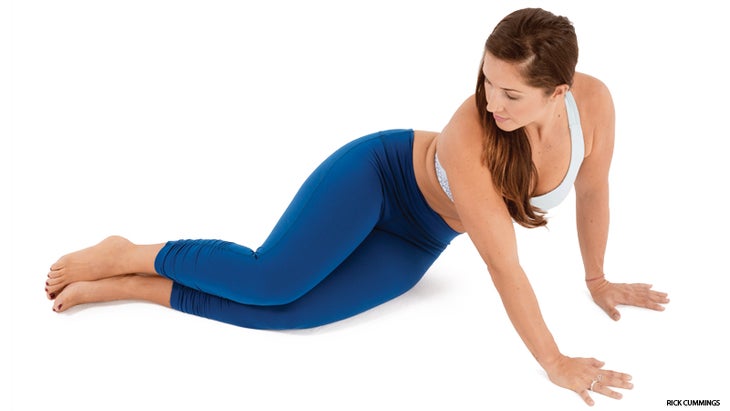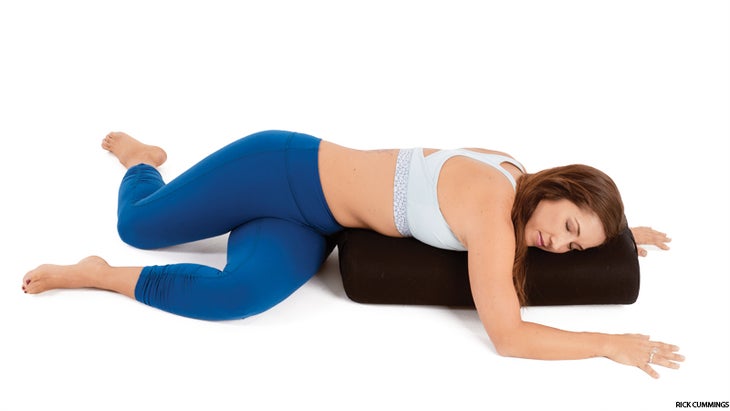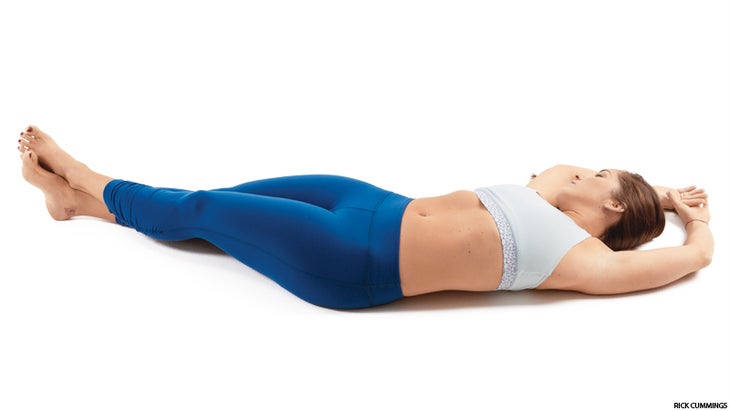Heading out the door? Read this article on the new Outside+ app available now on iOS devices for members! Download the app.
Relieve hard-to-release back tension by unlocking your QL muscles.
Ever noticed a lingering ache deep in your low back after prolonged sitting or standing? When your back muscles are weak or you have poor posture, intrinsic rectangular muscles between your ribs and hips called the quadratus lumborums, or QLs, work overtime to stabilize your spine and pelvis, leaving them tight and sore. These deep muscles are also near critical organs like the kidneys and colon, which means that in addition to contributing to an achy back they can adversely affect your digestive health, and therefore energy and well-being, according to some alternative health practitioners.
Fortunately, yoga is one of the best methods for engaging these little-known muscles and keeping them agile and pain free. Releasing tension from your QLs will lengthen the sides of your lower back (i.e., your flanks), a process that can be exquisitely liberating, creating powerful feelings of relaxation within the abdomen, low back, and hips. To experience this, you first need to know exactly where your QL muscles are.
Your QLs originate on the internal side of the iliac crests (hip bones) and insert into the twelfth rib and the transverse processes—the boney, winglike protrusions on either side of the vertebrae—of the first through fourth lumbar vertebrae, L1–4. They sidebend your spine, help raise or “hike up” your hips one at a time, and extend your lumbar spine in poses like Uttanasana (Standing Forward Bend). Find your right QL by placing your right thumb on your back about halfway between your right side waist and your spine, and pressing into the space between your bottom rib and your hip. Then press in toward your transverse processes and hike up your right hip: You should feel your QL contract.
Your QLs get tight and tender when they have to kick in and compensate for poor posture. And often soreness is one-sided, due, say, to carrying a small child on one side or side-sleeping with your top hip hiked up every night. Leg-length discrepancies are also a common cause of QL tension—most people have a slight variance in leg length, and around 2o percent of people have a clinically significant (greater than 2 cm) difference.
Yoga offers a host of poses to stretch your sides—and your QLs. Standing poses like Utthita Trikonasana (Extended Triangle Pose) and Utthita Parsvakonasana (Extended Side Angle Pose), and seated poses like Parsva Upavistha Konasana (Side Seated Wide Angle Pose) and Parivrtta Janu Sirsasana (Revolved Head-of-the-Knee Pose), can help you access a QL stretch. As you warm up for the restorative sequence, designed to create ease around your lumbar spine, first work on releasing any tightness in your hips and thighs. This will free up your pelvis and allow for a deeper stretch in your QLs.
4 Poses to Free Your Flanks
Combine these exercises to bring more mobility to your lumbar spine and sides and to find greater range of motion in sidebending poses.
Picking Apples

Start in Tadasana (Mountain Pose) with your arms and hands reaching skyward. Reach your left hand way up, as if trying to pluck a ripe apple that’s just out of reach. Bend your right knee and hike up your right hip. Inhale and feel a stretch in your left QL; exhale to release. Switch sides, then repeat for up to 10 rounds.
See also Anatomy 101: Understand + Prevent Hamstring Injury
Flank Stretch

Come to your hands and knees, aligning your hands under your shoulders. Allow your knees and inner thighs to touch, aligning them under your pubic bone. Drop your hips to the left as far as you comfortably can, by rolling onto the outside of your left leg with the right stacked on top. Then take a look over your right shoulder. Breathe into the stretch along the left side of your lower back and hip. Exhale to come back through center and move to the other side. After several rounds, come into Balasana (Child’s Pose) over a bolster or blankets and take several long, slow breaths.
See also The Anatomy of a Satisfying Side Stretch
Belly-Down Twist

Place the bolster against your left hip, then turn your torso toward the bolster. Keep length in your spine, place your hands on either side of the bolster, and lower your torso until your ribs and chest are supported. Turn your head in the direction that’s most comfortable for you. Play with the bend in your hips and knees to find the sweetest stretch in your right flank, allowing the right hip to stretch away from the lower ribs. Rest here for several minutes. When you’re ready to come up, unwind very slowly with deep breaths. Repeat the stretch on the opposite side.
See also Anatomy 101: Understand Your Pectoralis Minor
Reclined Palm Tree Pose

Lying on your back, bring your spine into lateral flexion, bending to the right. Keep the hips and shoulders on the floor. Grasp your right wrist with your left hand. Then move the feet to the right; if it helps, cross the ankles to hold the legs in place. Allow the entire left side of your body to stretch. Stay here for several minutes, then come back to center and repeat on the other side.
Finish with Savasana (Corpse Pose), resting with the bolster under your knees for 5–10 minutes, and enjoy the space in your sides from ribs to hips.